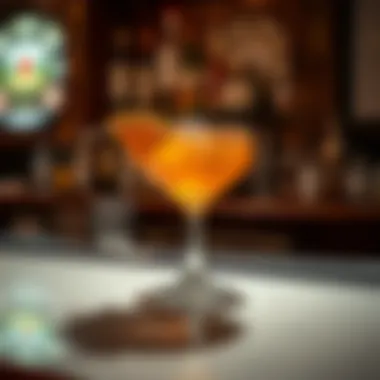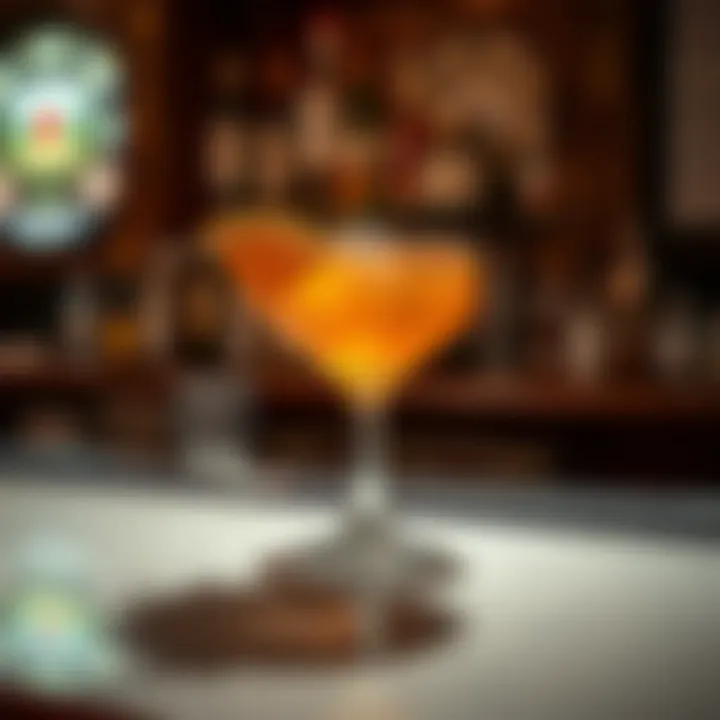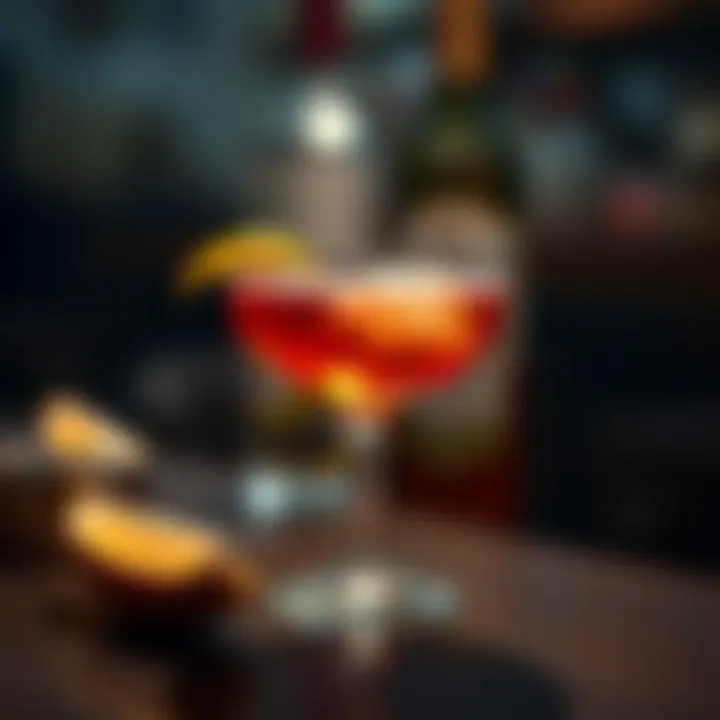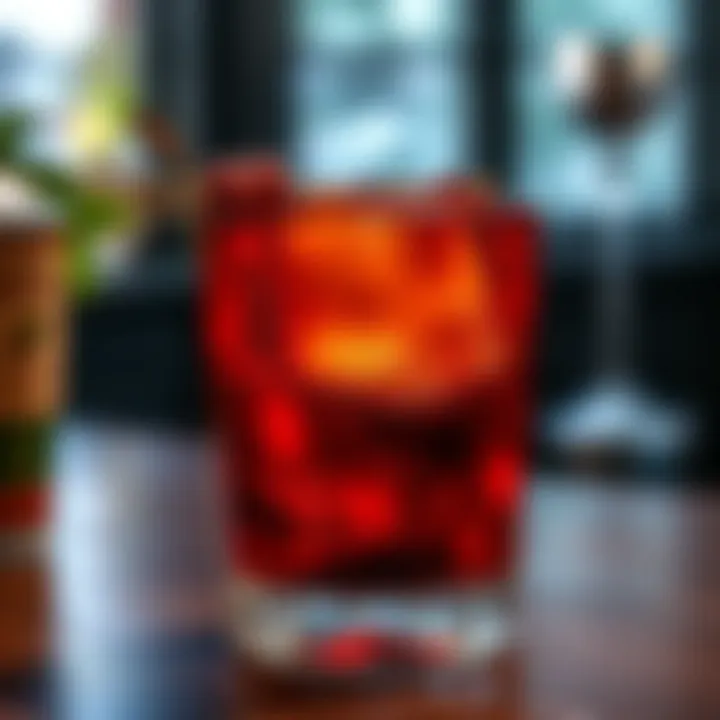The Rich Legacy of the Manhattan Cocktail


Intro
The Manhattan cocktail stands as a testament to the elegance and complexity of cocktail culture in America. With roots tracing back to the mid-19th century, this drink has transformed from a humble mixture of spirits to a symbol of sophistication in countless bars and homes. As we dive into the history of the Manhattan, it’s crucial to understand not just how it’s made, but why it holds such a significant place in the tapestry of American mixology.
The cocktail’s journey is a reflection of societal changes, shifts in taste, and the influences of various cultures. From the bustling speakeasies of Prohibition to today’s craft cocktail bars, the Manhattan has adapted, yet it has retained the core elements that make it iconic. This exploration will illuminate the ingredients, preparation methods, variations, and the cultural significance of the Manhattan.
Let’s start by examining the essential components that create this classic cocktail.
The Origins of the Manhattan Cocktail
The Manhattan cocktail, often seen as the quintessential representation of American mixology, holds a significant place in the history of cocktails. Its origins are more than just a tale of a drink; they encapsulate the cultural milieu of 19th-century America, where social gatherings and the burgeoning bar scene were starting to flourish. The Manhattan's story intertwines with the evolution of cocktail culture, reflecting changes in societal norms, tastes, and even the availability of ingredients.
The significance of delving into the origins of the Manhattan cocktail lies not only in appreciating its flavor profile but also in understanding its role as a predictor of future cocktail trends. This section will lead us through the historical context that shaped this iconic drink, followed by a look into the first recipes that began circulating among early enthusiasts.
Historical Context
To truly grasp the essence of the Manhattan, one must consider the backdrop of the mid-1800s. This was a period marked by rapid change in America. The country was undergoing urbanization, with cities like New York growing exponentially. Saloons and bars became centers of social life, serving as places where people from all walks of life convened. Cocktail culture, as a result, began to emerge, fueled by imported spirits and the creativity of bartenders eager to please an increasingly discerning clientele.
During this era, the introduction of vermouth, a fortified wine with aromatic spices, became widely popular. The blending of whiskey with this new ingredient was a game changer. Not only did it balance the robust flavor of the whiskey, but it also beckoned a sense of refinement and sophistication to the drink. It's said that amidst the clamoring of patrons in dimly lit saloons, the Manhattan was born, rumored to have been mixed to celebrate a political event at the Manhattan Club. However, the true origin story likely teems with more than one narrative, reflecting the diversity of the city and its inhabitants.
First Recipes and Documentation
The first mentions of the Manhattan cocktail can be traced back to the 1860s, a time when the craft of cocktail mixing was becoming more structured and documented. One of the earliest known recipes for the Manhattan appeared in "The Bartender’s Guide" by Jerry Thomas, published in 1862. The recipe was simple but effective, calling for rye whiskey, sweet vermouth, and a dash of bitters, stirred over ice and strained into a glass.
Documentation of this drink comes not just from publications but also from menus in upscale establishments where dignitaries and socialites gathered. Visitors to these bars often took note of the drink's popularity, and it wasn't long before the Manhattan was the toast of the town. Practically, the drink's appeal lay in its balance—a symphony of flavors that suggested both comfort and elegance.
"The Manhattan was not just a drink; it became a symbol of an era, showcasing the art of cocktail mixing that mirrored the grandeur of urban life. It allowed patrons a moment of respite from their daily hustle, offering a taste of sophistication."
As the cocktail gained popularity, variations began to emerge, leading to endless adaptations that keep the essence of the Manhattan alive today. This rich history sets the stage for understanding not only how the Manhattan cocktail became a staple in bars but also why it continues to capture the hearts of drinkers globally.
Key Ingredients of the Manhattan
The Manhattan cocktail stands as a testament to the perfect harmony of flavors, showcasing key ingredients that form its backbone. When one takes a sip of this classic drink, they taste not just a concoction of spirits, but a well-thought-out blend that tells a story of sophistication and tradition. Understanding these key ingredients is essential to appreciating the cocktail’s rich history and its evolution over the years.
Whiskey Choices
At the heart of any Manhattan lies whiskey, and the choice of which one to use can make or break the drink. While rye whiskey has traditionally been the go-to for a classic Manhattan due to its spiciness and bold character, bourbon has also gained popularity for its sweeter undertones. Some bartenders even opt for a blended whiskey, which can add a smoother finish. It’s worth noting that both the quality and branding of the whiskey greatly influence the overall flavor profile. Brands like Bulleit, Maker’s Mark, and Rittenhouse often find their way into many a mixologist's toolkit, each lending its distinct nuances.
The choice of whiskey can set the tone for the entire experience—choosing a high-quality spirit elevates the Manhattan from ordinary to extraordinary.
Vermouth Variations
Vermouth is another crucial element that contributes much to the Manhattan's identity. Sweet vermouth, typically Italian, is the standard in most recipes, but dry vermouth and even bianco vermouth can be explored for unique variations. Sweet vermouth adds a rich, herbal sweetness that balances the bite of the whiskey, while dry vermouth offers a sharper, more refreshing profile. When selecting a vermouth, brands like Carpano Antica and Dolin are often favored, known for their rich flavors and high quality. The choice of vermouth can also introduce new dimensions to the cocktail, enhancing its complexity.


The Role of Bitters
Bitters, often overlooked, play an essential supporting role in the Manhattan cocktail. These concentrated herbal tinctures bring depth and complexity, rounding out the sweet and woody notes from the vermouth and whiskey. The classic Angostura bitters are the staple, providing a slightly spicy and aromatic touch. However, many modern mixologists experiment with other types, such as orange bitters or even specialized craft bitters, to create a signature twist. The right amount of bitters—usually just a dash or two—can elevate the drink significantly, balancing flavors perfectly.
In sum, the ingredients in a Manhattan are more than mere components; they are the lifeblood of the cocktail, contributing to its legacy and ongoing evolution. By appreciating the nuances of whiskey, vermouth, and bitters, one can truly savor each sip of this distinguished drink.
The Manhattan's Evolution Through the Years
The Manhattan cocktail, with its complex layers and rich flavors, has seen significant transformations since its inception. Understanding how it evolved over the years provides insight into not just the drink itself, but also the broader evolution of cocktail culture in America. This section delves into the pivotal moments that influenced the Manhattan, particularly the effects of Prohibition and the recent revival in the craft cocktail movement.
Prohibition and Its Impact
Prohibition, which lasted from 1920 to 1933, was a significant turning point in the history of the Manhattan cocktail. During this period, the production, sale, and transportation of alcoholic beverages were banned across the United States. While one might assume that the cocktail's popularity would plummet, the opposite occurred.
Instead of fading into obscurity, the Manhattan adapted. Many skilled bartenders found ways to continue their craft, often working clandestinely in speakeasies. The Manhattan's balanced blend of whiskey, vermouth, and bitters allowed for creativity. Bartenders began to experiment with various ingredients to mask the often inferior quality of spirits that were available on the black market. This innovation led to variations where the proportions of whiskey to sweet vermouth were adjusted, and different types of bitters were tried out, forever reshaping its identity.
Additionally, Prohibition highlighted the cultural significance of the cocktail as a symbol of rebellion. Enjoying a Manhattan while navigating the risk of law enforcement became a statement of sophistication and defiance. It carved a place for the drink not only in social circles but in the heart of American folklore, where the cocktail became more than just a beverage, but a representation of a lifestyle. The perception of the Manhattan morphed into something of a badge of honor amongst the elite.
Revival in the Craft Cocktail Movement
Fast forward to the late 20th century and the early 21st century, when the craft cocktail movement began to gain momentum. As a response to the mass production and sugar-laden cocktails of the past, enthusiasts sought to return to simplicity and quality. The Manhattan found itself in the spotlight once again, embraced by bartenders who revered its history and sought to honor its classic roots.
The craft movement emphasized the quality of ingredients and the artistry of mixing, leading to a renaissance for drinks like the Manhattan. Bartenders began sourcing premium whiskeys, top-notch vermouths, and artisanal bitters, which only elevated the cocktail’s reputation. This era encouraged creativity, giving rise to various interpretations of the Manhattan: from the dry Manhattan to the perfect Manhattan, each variant showcasing different flavor profiles.
Moreover, the resurgence of appreciation for local distilleries and small-batch producers further contributed to its evolution. Cocktails today often reflect the local landscape, as ingredients become regionally influenced. This blend of traditional techniques and modern flavors ensures the Manhattan remains relevant and exciting in today’s bars.
"The Manhattan has survived the test of time, reshaping itself to remain in vogue, always connecting the past to the present."
As time flows, the Manhattan cocktail stands as a testament to resilience. Its journey through Prohibition and into the current craft cocktail renaissance reveals more than mere changes in recipes; it uncovers deeper layers of cultural significance that resonate with enthusiasts today. The Manhattan continues to thrive, evolving yet rooted firmly in its celebrated history.
Cultural Significance of the Manhattan
The Manhattan cocktail has transcended its role as just a beverage; it stands as an emblem of sophistication, culture, and history. Its place in American society is intricate, reflecting not only the evolution of cocktail culture but also the societal changes that occurred throughout its existence. As a drink that has graced the upscale establishments of the past and continues to be a fixture in modern bars, the Manhattan portrays a narrative filled with tradition and adaptation.
Representation in Literature and Film
The Manhattan's presence in literature and film showcases its role as a cultural icon. The drink often appears in scenes that emphasize class, elegance, and social interactions. Numerous authors and filmmakers have utilized the Manhattan as a symbol, conveying a sense of status or sophistication.
In Ernest Hemingway’s "A Moveable Feast," for instance, the cocktail is part of the backdrop of Parisian cafés, evoking images of expatriates amid their creative pursuits, sipping cocktails while discussing life and art. Similarly, in the classic film "The Apartment," the character portrayed by Jack Lemmon often reaches for a Manhattan, which signifies his attempt to navigate the complexities of adult life and romance. This drink is a thread that connects characters to their aspirations and social environments.
“A cocktail is a symbol of indulging in the finer things; the Manhattan epitomizes the blend of rich flavors and social history.”
The Manhattan has also made its mark on popular series and television shows like Mad Men, where it becomes more than just a drink; it’s a portrayal of the 1960s corporate culture and the men and women who navigated it. Through various portrayals, the Manhattan acts as a silent character, contributing to the storylines and enhancing the atmosphere in which these narratives unfold.


The Manhattan as a Symbol of Sophistication
The Manhattan exudes an air of sophistication that is hard to overlook. This cocktail's composition—a blend of whiskey, sweet vermouth, and bitters—creates a rich tapestry of flavors, appealing to those with refined palates. Choosing to order or prepare a Manhattan often conveys a certain level of confidence and knowledge about classic cocktails.
Not only is it a favorite among cocktail connoisseurs, but it also serves to bridge generational gaps. The drink has adapted over the decades, yet it has remained a staple of cocktail culture. Many high-end bars craft bespoke Manhattans, exploring various whiskey and vermouth pairings, catering to the adventurous and discerning drinker.
Furthermore, the inclusion of the Manhattan in numerous high-profile events, galas, and celebrations reinforces its status as a drink suited for special occasions, reinforcing the idea of it being a symbol of class. When one raises a glass of Manhattan, it is not merely to enjoy the drink but also to partake in a tradition that has stood the test of time.
In summary, the cultural significance of the Manhattan extends beyond its ingredients. It is interwoven with the fabric of American history and represents a rich story of change, adaptation, and enduring appeal. As we continue to explore this cocktail, we see that its legacy of sophistication is reflective of the society that embraced it.
Classic and Contemporary Variations
The Manhattan cocktail is not just a drink; it’s a symbol of tradition interwoven with innovation. When we delve into the classic and contemporary variations, we uncover the nuances that have evolved over time and the creativity that bartenders have embraced. Classic styles signal back to the drink’s roots, while modern interpretations reflect changing tastes and the resurgence of mixology as an art form.
Exploring both realms illuminates not only the cocktail's adaptability but also its capacity to maintain relevance across generations.
Different Styles and Recipes
Different styles of the Manhattan vary based on the whiskey used, the type of vermouth chosen, and sometimes the bitters. This cocktail can be constructed with either rye or bourbon, and each spirit brings its unique flavor profile to the mix.
- Classic Manhattan: Traditionally made with rye whiskey, a sweet vermouth, and Angostura bitters, garnished with a cherry. This version harks back to the cocktail's origins.
- Perfect Manhattan: This variation utilizes both sweet and dry vermouth, lending a complexity that balances the spicy notes of rye or bourbon, making it a favorite amongst more discerning palates.
- Robust Manhattan: Using a higher proof bourbon or a single malt whiskey like a cask-strength Scotch adds a bold intensity, perfect for those with a more robust flavor preference.
- Vodka Manhattan: For those who prefer a smoother and less aromatic option, substituting vodka for whiskey creates a gentler experience, though some purists might raise an eyebrow.
Each variation provides a new experience while retaining the essential nature of the Manhattan.
Innovative Twists on the Traditional Recipe
As bartenders explore further, the classic Manhattan has morphed into creative expressions that marry tradition with innovation. Here are some flavorful twists:
- Smoked Manhattan: Utilizing a smoking gun, this approach infuses the drink with rich, charred notes, often incorporating smoked bitters or a touch of mezcal for depth.
- Chocolate Manhattan: Adding chocolate bitters or even a splash of chocolate liqueur introduces a dessert-like quality, making this a hit for those who love sweeter cocktails.
- Herbal Variations: Some have begun substituting traditional herbs like basil or thyme, blending these with the other ingredients to create a refreshing herbal twist that brightens the drink.
These inventive twists show how the Manhattan cocktail continues to inspire creativity while encouraging bartenders and cocktail enthusiasts alike to explore flavors that resonate with personal tastes.
"A cocktail may only be a reflection of its time, but when we change the recipe, we also change its story."
The Manhattan in Modern Bartending
The Manhattan cocktail, with its deep roots in mixology, continues to hold a distinguished place in the realm of modern bartending. As bartenders seek not just to serve drinks but to craft experiences, understanding the nuances of preparing a classic Manhattan becomes essential. This cocktail, primarily made of whiskey, sweet vermouth, and bitters, reflects both simplicity and complexity, allowing for an expressive medium through which bartenders can showcase their skills.
In today's cocktail culture, the Manhattan stands as a muscial note that resonates with enthusiasts. Crafting this drink is not merely about following a recipe; it's an art form that brings together flavors, techniques, and personal touches. Mastering the Manhattan equips bartenders with profound knowledge about spirits and blends, enhancing their creativity behind the bar.
Bartending Techniques for Crafting the Perfect Manhattan
When it comes to preparing a Manhattan, several key techniques elevate the drink from ordinary to extraordinary.


- Choosing the Right Whiskey
The whiskey selection is pivotal. Rye whiskey provides a spicy, bold character, while bourbon lends a sweeter, smoother palate. It's essential to taste various brands like Bulleit Bourbon or Rittenhouse Rye, understanding their distinct profiles before making a choice. - Proper Mixing Method
Traditionally, the Manhattan is stirred, not shaken. This method ensures a silky texture without diluting the flavors. Use ice cubes that are large and solid to keep the drink cold while minimizing water contribution. - Perfect Ratio
A common ratio is 2 parts whiskey to 1 part vermouth. However, tweaking this ratio according to personal taste can lead to exciting discoveries. Remember, the right balance showcases the drink's character. - Bitters Application
The bitters introduced are non-negotiable in a classic Manhattan. Angostura bitters are standard, but experimenting with orange bitters or even specialty bitters can add unique flavors. - Garnishing
A simple maraschino cherry or an orange twist can enhance the aroma and visual appeal. Knowing how to properly garnish is part of the bartending finesse. - Serving Temperature
A chilled glass is a non-negotiable. A cold cocktail glass keeps the drink cool longer, maintaining its integrity until the last sip.
"The beauty of the Manhattan is not just in its taste, but in the experience of crafting it. Each step invites creativity and showcases a bartender's individual flair."
By refining these techniques, modern bartenders not only pay homage to the tradition that the Manhattan embodies but also push the limits of creativity. The cocktail serves as a conversation starter and a statement—one that highlights a bartender's dedication to their craft.
As contemporary drinking culture evolves, so does the Manhattan; bartenders continue to reinterpret flavor profiles and presentation, allowing this iconic cocktail to remain relevant and intriguing for generations to come.
Pairing the Manhattan with Food
Pairing food with the Manhattan cocktail isn’t just a matter of what tastes good. It’s about balancing flavors, textures, and how the drink complements a dish's overall profile. The Manhattan, with its robust whiskey base, sweet vermouth, and aromatic bitters, offers a complex palate experience that can elevate a meal to new heights. Understanding the intricacies of these combinations reveals not only the versatility of the Manhattan but also its potential to enhance dining experiences. Here are some specific elements and considerations to keep in mind when pairing the Manhattan with food.
Complementing Appetizers
When it comes to starting your meal, appetizers should whet the appetite without overpowering the senses. The Manhattan's smooth yet punchy character makes it a perfect companion for a range of starters. Think about charcuterie boards laden with cured meats and cheeses. The saltiness of prosciutto or the nuttiness of aged gouda can play beautifully with the sweetness of the vermouth.
- Seafood options, especially oysters, can be surprisingly harmonious. The briny quality of oysters combined with the Manhattan's herbal notes creates an engaging contrast that delights.
- Dishes like stuffed mushrooms or cheese fritters can also work well. The richness of cheese and the earthiness of mushrooms pair nicely with whiskey's complex flavor profile.
Entrees That Pair Well
Main courses can take on a life of their own when paired thoughtfully with a Manhattan. The whiskey tends to harmonize nicely with rich and hearty dishes. For example, grilled steak can be a match made in culinary heaven. A well-cooked ribeye, with its fatty marbling, stands up to the cocktail’s bold flavors, while also allowing the drink to cut through the richness of the meat.
- Vegetarian options like mushroom risotto offer earthy notes that complement the whiskey nicely. The sweetness from the vermouth can create a delightful balance with the dish’s creaminess.
- Spicy Barbecue Ribs can also be considered, as the icy cold Manhattan can temper the heat often found in BBQ sauces while enhancing the overall smoky flavor.
Desserts That Enhance the Experience
Concluding a meal with dessert can be a delicate dance, especially when you're working with such a rich cocktail. Pairing the Manhattan with sweets comes down to finding items with enough body and flavor to keep up with its profile.
- Rich chocolate desserts, such as a dense flourless cake or dark chocolate mousse, pair very well. The bitter notes in the chocolate can highlight the bitters in the cocktail, allowing for a well-rounded finish.
- Alternatively, spiced desserts, like ginger cake or a slice of pecan pie, can amplify the cocktail’s warmth. The spices can create a comforting symphony that lingers on the palate.
"A well-prepared Manhattan doesn’t just accompany a meal; it transforms the dining experience. Each sip can echo the flavors of the food, creating a truly memorable occasion."
In the end, the beauty of pairing food with a Manhattan lies in experimentation. Whether it’s the start, the heart, or the finish of your meal, the aim is to create a balance that tantalizes the taste buds and enriches the dining experience.
Culmination
The story of the Manhattan cocktail is more than just about a drink; it encompasses a significant part of American cultural history. This cocktail has transcended its humble beginnings, evolving into a symbol of sophistication and artistry in mixology. Its enduring legacy speaks volumes. From its genesis in the 19th century to its resurgence during the craft cocktail movement, the Manhattan has continually adapted to changes in tastes and culture.
The Manhattan's Enduring Legacy
One striking element of the Manhattan’s legacy is its ability to remain relevant through generations. What was once a favored beverage of the elite gradually found its way into the hands of bartenders and cocktail enthusiasts everywhere. The Manhattan is now a staple on drink menus around the world, affirming its status as a classic.
Key elements that contribute to its lasting impression include:
- Cultural Representation: The Manhattan has found its way into various aspects of popular culture, from literature to films. Think of the image of a suave character sipping a Manhattan in a dimly lit bar, capturing an air of refinement and taste.
- Craftsmanship in Mixology: The drink is a showcase for bartenders to display their skills, allowing for endless variations while adhering to the fundamental recipe. This adaptability introduces newcomers to the world of cocktails while exciting seasoned drinkers with innovative twists.
- Simplicity Meets Elegance: At its core, the Manhattan is simple—a blend of whiskey, vermouth, and bitters. This simplicity allows the drink to be approachable, yet the layers of flavor it possesses cater to sophisticated palates.
The Manhattan cocktail, while modest in its ingredients, tells a complex story of tradition, adaptability, and the timeless art of cocktail making.
In sum, the Manhattan is not viewed simply as another cocktail; it is a narrative woven into the fabric of mixology. Its ability to evolve while maintaining its heritage makes it a continually fascinating subject for both casual drinkers and serious enthusiasts. As we push further into modern cocktail culture, the Manhattan remains an enduring reminder of where we’ve been and a basis for where we’re headed.







